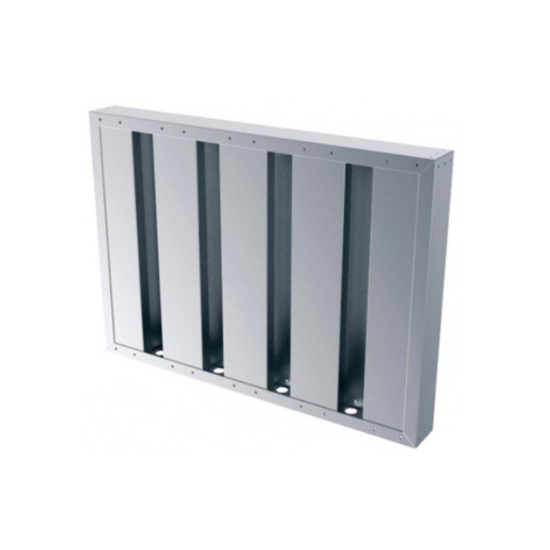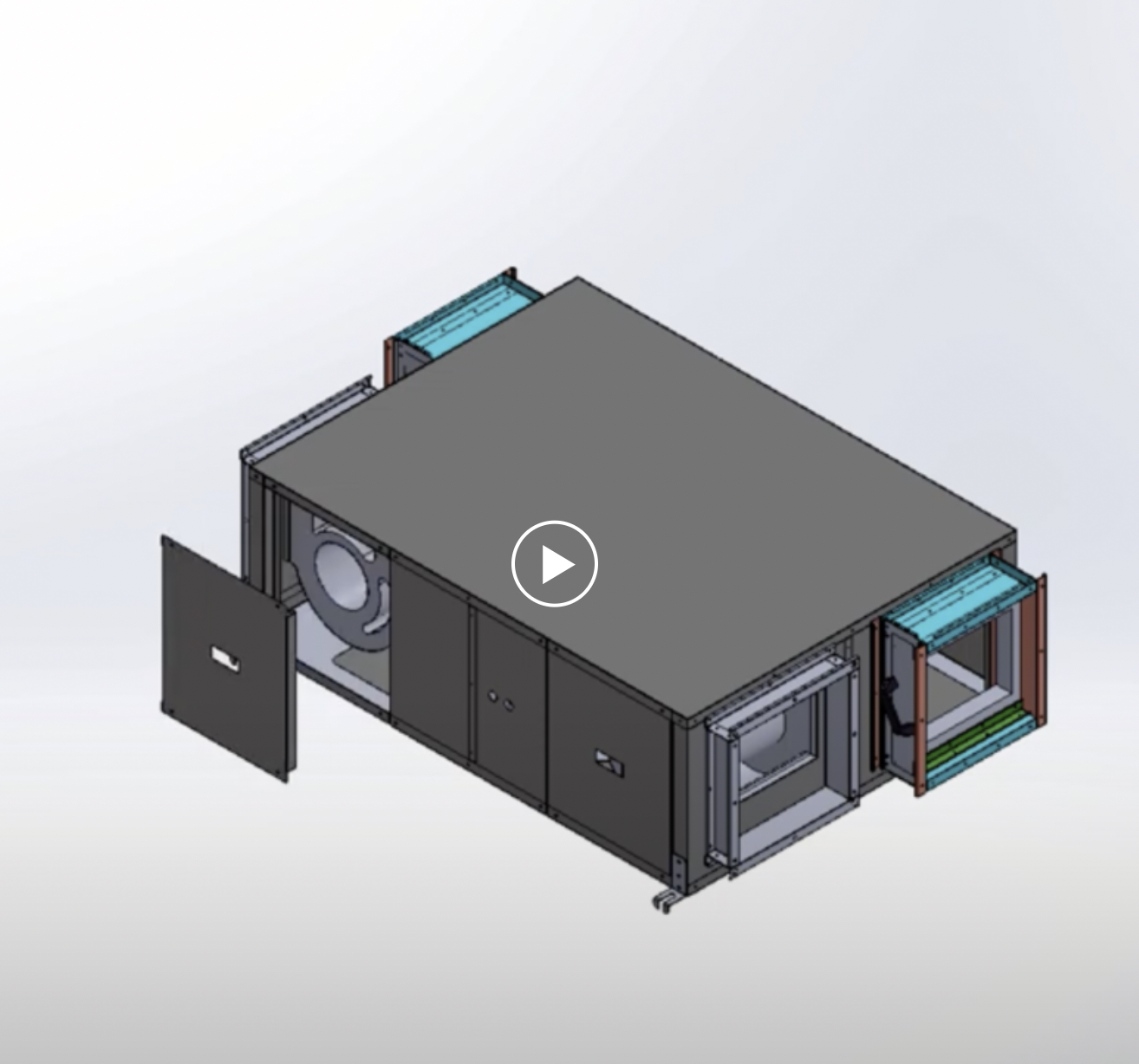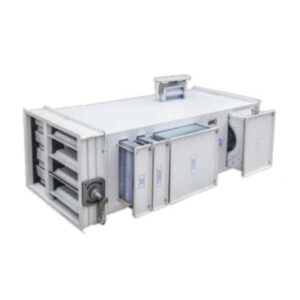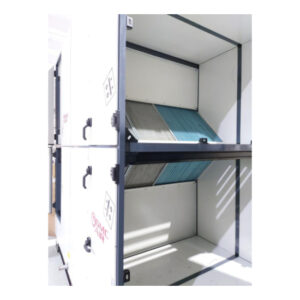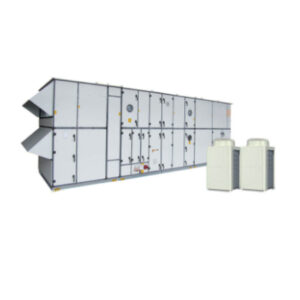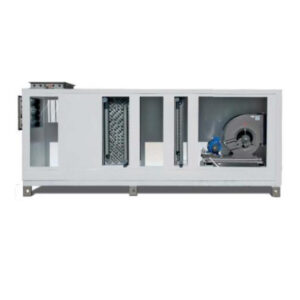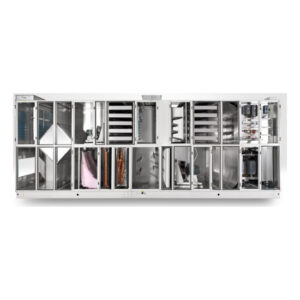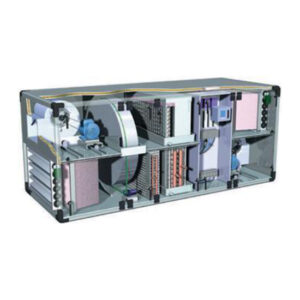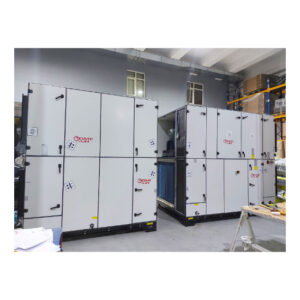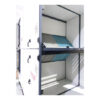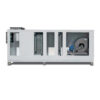Overview
DX Batteries provide discharge of heat to the atmosphere by transfer from the evaporator to the refrigerant with a cooling medium. The refrigerant is evaporated directly at the heat transfer source.
Advantages of DX Battery Equipped Air Handling Units
-Losses are minimal compared to conventional systems
-Higher cooling coefficients, lower operating costs
-Low setup time
-Lower maintenance cost compared to other systems
-Assembly effort and cost advantage
-Lower operating costs for heating and cooling
-Heating and cooling can be done with a single outdoor VRF unit (heat pump).
-Provides easy and fast solution to small and medium sized facilities with a single investment.
-No risk of frozen coils
-Local control enables only required power consumption
-No energy loss from cooling pipes: a general problem with conventional systems
-Longer life than conventional systems
-Low noise levels
Standard DX battery frame is made of galvanized steel sheets. The exchanger block is made of copper tubes and aluminum fins.
Exchanger Design Choices:
-Frame: Galvanized steel (Epoxy coating), aluminum (Al Mg), stainless steel AISI 304 or AISI 316
-Tubes: Copper
-Fins: Aluminum, epoxy coated aluminum
-Collectors: Copper
DX batteries can be designed for the refrigerants: R314a (C2H2F4), R152a (C2H4F2), R404A (mixture), R407C (mixture), R410A (mixture).
Guide rails are assembled into the units to enable easy removal of batteries for cleaning and maintenance. DX batteries are placed inside the unit with a condensation pan including a 32mm diameter drain pipe
USAGE
We can list the most required basic features of VRF&DX air handling units as; working with high efficiency and climatization with less energy consumption, air tightness, having a construction that would minimize thermal bridges and that is not vibrating by dynamic forces, ease of installation, maintenance and transportation. In VRF&DX air handling units designs and selections are made by given priority to operating costs and efficiency. To provide and support these priorities in our devices we use energy-saving fans, efficient heat recovery exchangers and coils and we design interior structure of air handling units to provide optimum air flow. Higher levels of efficiency can be achieved by using our optional automation systems.
Ventilator and Aspirator Units
GMCAIR air handling unit's ventilator or aspirator units are produced in standard chamber structure. While ventilator and aspirators can be chosen as forward or backward curved blades, radial single/double suction fans balanced statically and/or dynamically, they can also be designed with plug-fan. Electrical motor of fans are montaged on to the same chassis. In order to prevent the vibration that can be occured especially within this chamber, to the other part of the air handling unit, rubber or spring type vibration isolator is used at an amount and size dependent on the capacity, size, fan and motor cycles of the unit.
Belt and Pulleys
Pulleys used in fans and motors are V-belt pulleys appropriate to DIN 2211 and TS 148 norms. Pulleys are formed in two parts. Since, after the first part is mounted in fabric to the fan and motor spindle, the second part can be mounted without a need for a hardware, pulley size can be made very easily upon need.
In order to transfer power between motor and fan pulleys, narrow V-belts (appropriate to TS 198/40 DIN 7753/1) or classical V-belts (appropriate to TS 198/1 DIN 2215) are used. Moreover, there is a belt stretching mechanism for adjusting the belt tightness between the fan and motor to the desired and efficient level.
Filters
Montage frames are designed for different filter classes used together with air handling units for several different purposes. Thanks to this design, filters can be placed very easily into their sockets with spring systems. Moreover, with this design, any possible by-pass that can be occured at filters are reduced to minimal levels. G3-G4 class filters used as front-side filters, have galvanized frames, and with galvanized string connections, they are installed with increased resistance to air flow.
Bag filters with different classes are used as second-level filters in air handling units. Besides, they are used as first-level filters for hygienic air handling units. Bag filters can be chosen out of F5 to F9 classes. In air handling units, rigid filters can be used as the last filter at between classes F5 to F9 upon need. In order to filter undesired odor, active carbon filters both with carbon imbued panel or with cartridge, can be used.
Silencer
Silencer modules are manufactured in standard cell structure. Rock wool or glass wool is used in silencers. Different numbers of columns can be used within the cell depending on sound attenuation features with respect to capacity and size.
Please have a look on product catalogs for technical details ..

